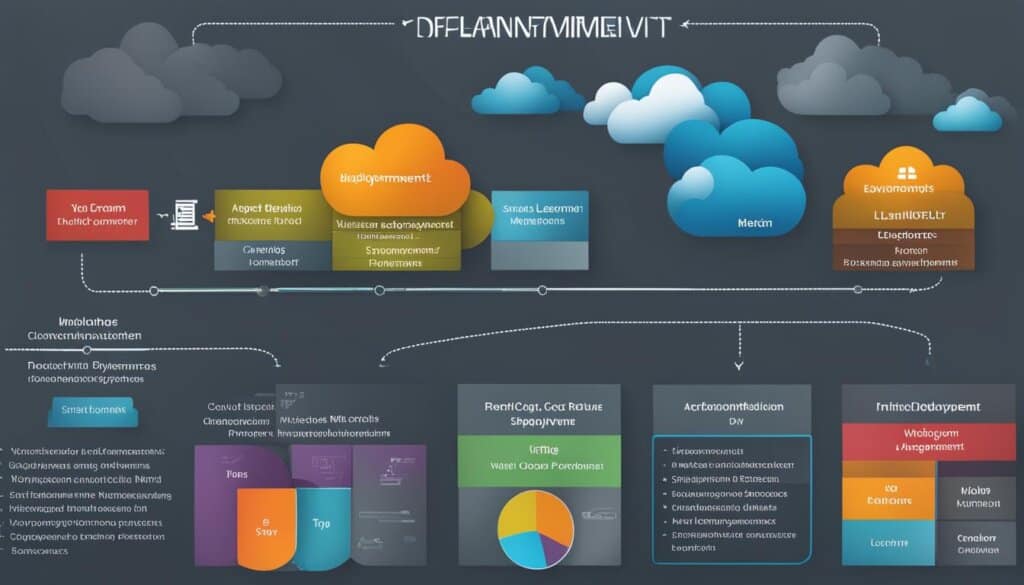Table of Contents
Learning Management Systems (LMS) are an essential part of e-learning practices, utilizing software applications and web-based technology. LMSes serve as a platform for instructors, students, and administrators to plan, implement, and assess specific learning processes.
With an LMS, instructors gain the ability to create and deliver content, monitor student participation, and assess performance efficiently. This innovative tool can be utilized by businesses, government agencies, and educational institutions, enabling them to enhance educational methods, save time and money, and effectively manage various elements such as user registration, content, communication, quizzes, and certifications.
Let’s dive deeper into the benefits, functionality, and different deployment options of Learning Management Systems, as well as explore the advantages they offer to organizations seeking to revolutionize their e-learning practices.
Benefits of Learning Management Systems
Learning management systems (LMSes) provide numerous benefits to organizations, supporting knowledge management, onboarding, employee training, sales training, and blended learning. Let’s explore how LMSes enhance these areas:
- Knowledge Management: LMSes serve as powerful tools for gathering, organizing, and sharing knowledge resources and documents. They enable organizations to create centralized repositories where vital information can be stored and accessed by employees.
- Onboarding and Employee Training: LMSes play a crucial role in training new employees, ensuring a smooth onboarding process. They help deliver consistent and effective training materials, track progress, and gather valuable feedback to continuously improve the training experience.
- Sales Training: LMSes enable organizations to enhance sales skills through various methods such as seminars, customer interaction training, and case-based tutorials. These interactive modules empower sales teams to acquire the necessary knowledge and skills to excel in their roles.
- Blended Learning: LMSes facilitate blended learning experiences by combining traditional classroom teaching with online learning tools. This approach creates a more dynamic and personalized educational environment, offering learners the flexibility to access resources and engage in interactive activities whenever and wherever they prefer.
“A learning management system enables organizations to streamline knowledge sharing, training, and education, resulting in a more knowledgeable workforce and improved business performance.” – John Smith, Learning and Development Manager
By harnessing the power of LMSes, organizations can unlock their full potential in terms of knowledge acquisition, employee development, and overall growth. LMSes promote efficient and effective learning practices, empowering organizations to thrive in today’s competitive landscape.
| Benefits | Description |
|---|---|
| Knowledge Management | Gathering, organizing, and sharing knowledge resources and documents. |
| Onboarding and Employee Training | Smooth onboarding process, consistent training materials, and continuous improvement. |
| Sales Training | Enhancing sales skills through seminars, customer interaction training, and case-based tutorials. |
| Blended Learning | Combining traditional classroom teaching with online learning tools for a personalized educational experience. |
How Learning Management Systems Work
A learning management system (LMS) serves as a comprehensive repository, allowing users to store and track information in one centralized location. With features like responsive design, LMSes ensure that users can access the system seamlessly from any device, be it a desktop, tablet, or smartphone.
The user-friendly interface of LMSes facilitates easy navigation, enabling users to efficiently manage their learning tasks and objectives. Aligned with goals, the interface streamlines the learning process, ensuring a smooth and intuitive user experience.
LMSes also provide valuable reports and analytics, which offer insights into the effectiveness of online training initiatives. Through these reports, administrators and instructors can monitor learner progress, identify areas of improvement, and make data-driven decisions to enhance the learning experience.
Content interoperability and integration are vital features of LMSes, enabling seamless compatibility with other systems. This enables organizations to integrate various learning tools and resources, ensuring a cohesive and efficient learning ecosystem.
To support users’ learning journeys, LMSes offer a range of support services. Online discussion boards provide a platform for learners to interact, collaborate, and seek guidance from peers and instructors. Additionally, dedicated phone numbers and support teams cater to users’ needs, ensuring smooth operations and timely assistance.
Apart from user support, LMSes automate tasks such as user management, reducing administrative burdens. This automation saves time and allows instructors to focus more on delivering quality content and engaging with learners.
Furthermore, LMSes incorporate localization and AI features, providing personalized learning experiences tailored to individual users. These features enhance learner engagement and facilitate effective knowledge acquisition.
Overall, learning management systems function as comprehensive platforms that bring together various elements of online learning, offering storage, accessibility, analytics, and support services. By leveraging these systems, organizations can create engaging and efficient learning experiences for their users.
| Key Features | Benefits |
|---|---|
| Repository | Centralized storage and tracking of information |
| Responsive Design | Access from any device |
| User-friendly Interface | Easy navigation and aligned goals |
| Reports and Analytics | Insights into training effectiveness |
| Content Interoperability and Integration | Seamless compatibility with other systems |
| Support Services | Online discussion boards, dedicated phone numbers |
| Automation | Efficient user management |
| Localization and AI | Personalized learning experiences |
Types of Learning Management System Deployments
Learning management systems (LMSes) offer different deployment options to cater to various organizational needs. These options include cloud-based, self-hosted, third-party hosted, desktop application, and mobile application LMSes. Each deployment type has its distinct advantages and considerations.
Cloud-Based LMS
A cloud-based LMS is hosted on the cloud, allowing users to access it securely from any location using a username and password. This type of LMS offers flexibility and convenience as users can log in and access the system through a web browser. Cloud-based LMSes are popular for their scalability, as organizations can easily add or remove users as needed. Additionally, updates and maintenance are typically handled by the LMS provider, eliminating the need for organizations to manage the technical aspects.
Self-Hosted LMS
A self-hosted LMS involves installing the LMS software on the organization’s own computer or server. This deployment provides organizations with more control over the LMS and its data. It allows for customization and integration with other systems, providing a tailored learning experience. However, self-hosted LMSes require dedicated IT resources for maintenance, updates, and security. Organizations need to ensure they have the necessary infrastructure and technical expertise to manage the self-hosted LMS effectively.
Third-Party Hosted LMS
Third-party hosted LMSes are learning resources hosted by external providers. In this deployment model, organizations rely on a third-party vendor to maintain and manage the LMS. This option is suitable for organizations that prefer to outsource the technical aspects of LMS management. Third-party hosted LMSes can provide additional support services, scalability, and security depending on the vendor. Organizations should carefully evaluate the vendor’s reputation, reliability, and data protection measures before opting for a third-party hosted LMS.
Desktop Application LMS
Desktop application LMSes are installed directly on the user’s desktop or laptop computer. Once installed, users can access the LMS without an internet connection. Users may have the option to synchronize data with the server when they are online. Desktop application LMSes offer offline access to learning materials and can be convenient for organizations operating in areas with limited or unreliable internet connectivity. However, desktop application LMSes may have limitations in terms of real-time collaboration and access from multiple devices.
Mobile Application LMS
Mobile application LMSes enable users to access learning materials and resources on their mobile devices. This type of LMS is designed to provide a seamless and optimized learning experience on smartphones and tablets. Mobile application LMSes offer the flexibility to learn on the go, allowing learners to access courses and resources anytime, anywhere. They often leverage mobile-specific features such as push notifications, offline access, and responsive design to enhance the learning experience.

| LMS Deployment | Advantages |
|---|---|
| Cloud-Based | Convenient access from any location, scalability, automatic updates and maintenance |
| Self-Hosted | Customization, integration capabilities, greater control over data and system |
| Third-Party Hosted | Outsourced technical management, additional support services, scalability |
| Desktop Application | Offline access, suitable for areas with limited or unreliable internet connectivity |
| Mobile Application | Seamless learning on mobile devices, flexibility, optimized user experience |
Payment Options for Learning Management Systems
When it comes to learning management systems (LMSes), there are various payment options available to suit different needs and budgets. Here, we explore the different pricing models and licensing options that organizations can consider.
Freemium Models
One popular option is the freemium model, which allows users to access basic features of an LMS for free. This is a great option for organizations that are just starting out or have limited training needs. However, advanced functionalities usually come at an additional cost. The freemium model offers flexibility and allows organizations to upgrade as their needs grow.
Subscription Models
Another common payment option is the subscription model. With this model, users pay a recurring fee at regular intervals, such as monthly or annually, to access the LMS. Subscription models ensure continuous access to the system and often include ongoing support and updates. This is a convenient option for organizations looking for a hassle-free experience.
Licensing Models
Licensing models involve a one-time or annual fee for unlimited access to the LMS. One-time licensing fees are typically higher but offer lifetime access to the system without any recurring payments. On the other hand, annual licensing fees require organizations to renew their license each year to continue using the LMS. Licensing models provide organizations with complete ownership and control over their LMS.
Open Source LMSes
For organizations seeking more cost-effective options, open-source LMSes are available at no cost. Open-source LMS platforms, such as Chamilo, EdApp, Ilias, Moodle, and Sakai, are built by a community of developers who share their work freely. These platforms offer customizable and scalable solutions, allowing organizations to tailor the LMS to their specific requirements.
Choosing the right payment option for your learning management system depends on your organization’s needs, budget, and long-term goals. Consider the features, support, and scalability offered by each option to make an informed decision.
| Payment Option | Description |
|---|---|
| Freemium | Access to basic features for free, additional fees for advanced functionalities |
| Subscription | Recurring fee at regular intervals for continuous access to the LMS |
| Licensing | One-time or annual fee for unlimited access to the LMS |
| Open Source | No cost, customizable platforms built by a community of developers |
Advantages of Learning Management Systems
Learning management systems (LMSes) offer several advantages. One of the key benefits is the significant time and cost savings they provide. With LMSes, learners have the flexibility to complete their coursework at their own pace and in their preferred location. This eliminates the need for traditional training methods that involve instructors, training days, and travel expenses. By leveraging LMSes, organizations can optimize their learning processes and allocate resources more efficiently.
Another advantage of LMSes is the ability to monitor users’ learning progress and performance. Through the use of analytics and reporting features, organizations can gain valuable insights into learners’ strengths and weaknesses. This allows for targeted interventions and improvements in training materials to enhance the learning experience. By tracking learners’ progress, LMSes enable organizations to ensure that learning objectives are being met and that learners are acquiring the necessary skills and knowledge.
LMSes also provide personalized learning experiences, thanks to features such as artificial intelligence (AI) and gamification. These elements enhance learner engagement and motivation by tailoring the learning content to individual needs and preferences. AI-powered recommendations and adaptive learning paths enable learners to focus on areas where they need the most support, accelerating the learning process. Gamification elements like badges and leaderboards make learning fun and interactive, driving higher levels of participation and knowledge retention.
Automation is another key advantage of LMSes. Tasks such as user management, enrollment, and content delivery can be automated, reducing administrative burdens. This not only saves time but also ensures consistency and accuracy in training processes. With automated workflows, organizations can streamline their training operations and allocate resources to more critical tasks.
Furthermore, LMSes centralize training materials, making them easily accessible for learners. Instead of searching through multiple platforms or physical resources, learners can find all the necessary training content in one place. This centralized approach promotes consistency and convenience, enabling learners to access the materials they need when they need them. This results in a more efficient and effective learning experience.
In summary, learning management systems deliver valuable advantages to organizations. They offer time and cost savings, enable monitoring of learning progress, provide personalized learning experiences, streamline processes through automation, and centralize training materials. By leveraging the power of LMSes, organizations can enhance their learning and development initiatives and drive better outcomes for their learners.
FAQ
What is a learning management system (LMS)?
A learning management system (LMS) is a software application or web-based technology used for e-learning practices. It consists of a server that performs the base functionality and a user interface (UI) operated by instructors, students, and administrators.
How are learning management systems (LMSes) used?
LMSes are used to plan, implement, and assess specific learning processes. They provide instructors with a way to create and deliver content, monitor student participation, and assess student performance. LMSes can be used by businesses, government agencies, and educational institutions to improve educational methods, save time and money, and efficiently manage elements such as user registration, content, communication, quizzes, and certifications.
What are the benefits of learning management systems (LMSes)?
LMSes are beneficial to a range of organizations. They are used for knowledge management, onboarding and training employees, sales training, and blended learning. LMSes help organizations gather, organize, share, and analyze knowledge resources and documents. For employee training and onboarding, LMSes help train new employees and gather feedback to improve training materials. LMSes also enhance sales skills training through seminars, customer interaction training, and case-based tutorials. Additionally, LMSes offer blended learning experiences that combine traditional classroom teaching with online learning tools, resulting in more effective and personalized education.
How do learning management systems (LMSes) work?
A learning management system (LMS) can be thought of as a large repository where users store and track information in one place. LMSes have features such as responsive design, allowing users to access the system from any type of device. The user-friendly interface enables easy navigation and aligned goals. Reports and analytics provide insights into the effectiveness of online training initiatives. LMSes also support content interoperability and integration, allowing seamless compatibility with other systems. Support services such as online discussion boards and dedicated phone numbers are available. LMSes automate tasks like user management and offer localization and AI features for personalized learning experiences.
What are the different types of learning management system (LMS) deployments?
Learning management systems (LMSes) can be deployed in various ways. Cloud-based LMSes are hosted on the cloud, allowing users to access them from anywhere using a username and password. Self-hosted LMSes require the organization to install the software on their computer or access it via their company’s server. Third-party hosted LMSes are learning resources hosted by a third-party organization. Desktop application LMSes are installed on the user’s desktop but can still be accessible on multiple devices. Mobile application LMSes support a mobile learning environment and can be accessed on mobile devices.
What are the payment options for learning management systems (LMSes)?
Learning management systems (LMSes) offer various pricing models. Freemium models allow users to access basic features for free and impose fees for advanced functionalities. Subscription models require users to pay a recurring fee at regular intervals for access to the LMS. Licensing models involve either an annual fee or a one-time fee for unlimited lifetime access. Open-source LMSes are provided at no cost and include platforms like Chamilo, EdApp, Ilias, Moodle, and Sakai.
What are the advantages of learning management systems (LMSes)?
Learning management systems (LMSes) offer several advantages. They save organizations time and money by allowing learners to complete coursework at their own pace and in their preferred location, eliminating the need for instructors, training days, and travel expenses. LMSes enable organizations to monitor users’ learning progress and performance, providing valuable insights for improvement. LMSes also provide personalized learning experiences through features like AI and gamification. Automation streamlines tasks such as user management and enrollment. LMSes centralize training materials, making them easily accessible for learners.







